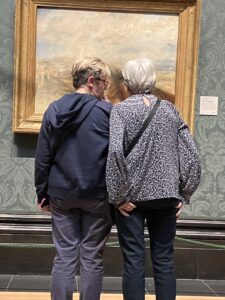Let’s talk about fiction, fictions, belief and the imagination
The word “fiction” comes from the Latin verb fingere, which gives us the English name for the digits of our hands, “finger,” which we also use as a verb, when we speak of “fingering someone,” meaning to manipulate (from Latin manus: “hand”).
Literally, fiction is something made by our fingers or something our fingers point to. The semantic range of the Latin verb fingo includes the following meanings:
- to shape, fashion, form, knead (dough)
- to adorn, dress, arrange
- to dissemble; I alter the truth in order to deceive; feign; pretend
- to train, teach, instruct
Fiction is something made to appear before our eyes, something conjured, an alteration of things found.
We can juxtapose fiction to fact, a derivation from the Latin factum, which is also something made. Facere can mean, or be used to express, the following range of actions: to make, do, act, name (in the sense of designate someone for a job, e.g., make him king), perform, work, build, construct, set (e.g. fire), achieve, to be effective, to cause, commit, concoct, establish, fabricate, and more.
We tend to think that facts are not fictions, but the words seem related, as are facts and fictions, if both are essentially made and the products of human (or divine or natural) making.
Facts and fictions are products of making. Facts are made things; fictions are made up things. Things are made or made up by someone or something, i.e., they have a cause. If everything is caused, everything is either fact or fiction. The distinction between fact and fiction points to the difference between intellect and imagination.
Anthropologically speaking, the human experience begins with toolmaking. A tool, say a stone flint, extends the range, strength, or ability of our fingers. It allows us to produce different and better facts. The human experience also begins with speech. Utterings are also a kind of tool in that they extend our range of power beyond the body. To use a spatial metaphor, speech extends our range in two directions, namely, inward and outward. Utterings are also “innerings.” The utterings of our mouths, the sounds we make with the intention of meaning, give voice to our inner lives, to the things we see, hear, taste, and feel and that we communicate with one another. With the ability to communicate comes the possibility of manipulating and dissembling, but also of instructing.
The first evidence of religion is also the first evidence of civilization, namely, the deliberate burial of human remains with gifts for the hereafter. From the very beginning, human lives were not just factual but fictional, playgrounds for the imagination. We may assume (or is it a fiction?) that early human worlds were populated, even dominated, by fictions. This is a probable assumption because we are aware of the arduous process by which humans have learned to distinguish between fact and fiction. The distinction between fact and fiction serves our interest in self-preservation. Knowing, what is fact and what is fiction, is a source of power. Knowledge is power, as the saying goes, but no knowledge is as powerful as the knowledge of causes. If I know the actual cause of a thing, I must no longer fear or enslave myself to fictitious causes. Knowledge liberates from enslavement to fictions.
Today we associate the struggle for the knowledge of true causes with the history of science. But where does that leave fiction?
Fiction remains a powerful tool of manipulation for the sake of power. Knowledge does not just liberate the knower from enslavement to fiction. It also enables the knower to create fictions and to manipulate others, by conjuring worlds that are equally or more compelling than facts. The art of using fiction to manipulate others is used in the rhetoric of persuasion, in propaganda, in advertisement and public relations, and of course in politics.
But fiction, the making of our imagination, is also a powerful tool for the powerless, who can imagine themselves as free and empowered.
The knowledge of facts comes with an element of disenchantment. The world of fiction is an enchanted world. We crave fiction more than facts.
Fiction can provide escape from facts. It exercises the imagination. When we are exposed to fiction as fiction, that is when we recognize that what we see, read, or hear is a product of the imagination, we suspend disbelief and enjoy the alternate reality of fiction. This may seem an entirely passive or receptive engagement, but it is, in fact (!), our own imagination that is at work producing the images, faces, feelings, and emotions that fiction conjures for us. This is particularly true where the medium provides mere clues but doesn’t paint the whole picture for us. Our imagination is more active in the production of fiction when we read than when we immerse ourselves in total works of art such as a musical, a movie, or computer-animated virtual reality.
It is our craving for fiction that makes us susceptible to manipulation. We want to believe what we are told, especially if the telling comes with the authority of religious power.
Realizing the difference between fact and fiction is a perennial task; it is work we practice every day and throughout our lives. We don’t already know whose words we trust or whose truth we can safely embrace. Higher education, really any education worthy of that name, encourages us to raise questions: “How do we know this?,” “Is this a fact, or is it a fiction?,” and “If this is fiction, is it harmless or harmful?”
***
Biblical literature is a complex mix of fact and fiction. On the borders of biblical literature, Jews, Christians, and Muslims each cultivated their own creative engagements with this literature. They have taken from it what they found compelling and instructive and they have made it into new complex mixes of facts and fictions. Modern biblical scholarship is the effort, begun in the 17th-century European Enlightenment, to break the spell or enchantment of the Bible, its hold on the European imagination, and subject it to the same scrutiny as the new science applied to nature. Textual and higher criticism treated biblical literature with the same critical tools scholars applied to any and all received bodies of literature. As archaeological and epigraphic knowledge grew, in the nineteenth century, new comparanda emerged that allowed scholars to see the emergence of biblical literature in its historical context and recognized the presuppositions and cultural assumptions shared by the biblical texts with other ancient texts and inscriptions. It stripped the Bible of its extraordinariness and established critical distance between modern readers and the ancient texts.
Traditional approaches to the Bible have the opposite purpose. Instead of distance they want to establish proximity and identification. Instead of rational and methodical critique they employed the imagination.
There are two major tools, among other traditional ways of creative engagement with biblical texts, namely, interpretation and embellishment.
Interpretation takes the text as sacrosanct, that is, as an unchangeable symbolic body or body of symbols, down to every word and even each letter, including misspellings, diligently copied from generation to generation. To make sense of this body of symbols, interpretation uses strategies such as allegorical interpretation, typology, and the like, to read the text otherwise than written. Using interpretative strategies to bend the text to the will of the interpreter treats the text as figurative rather than literal, i.e., it suggests that the text means more and other than it says. Late ancient and medieval exegetes spoke in this regard of a “fourfold sense” of Scripture, distinguishing, for example, between the literal (Jerusalem, the city), the tropological or moral (Jerusalem=the believer’s soul), the allegorical (Jerusalem=The Church), and anagogical (Jerusalem=Heaven, pointing to the eschatological future of individual or collective redemption). This would be a Christian example. A similarly ascending system of meanings is suggested by the Hebrew acronym PaRDeS (pshat, remez, drash, sod). There is evidence of creative interpretation in the Bible itself, e.g., when Daniel ponders the words of Prophet Jeremiah and finds a way of applying his prophecies to his own time. The library of Dead Sea Scrolls, uncovered at Khirbet Qumran since the late 1940’s, included the first known example of a commentary on a biblical book, the Pesher Habakuk.
The other strategy–embellishment or “corrective” retelling–is also evident among the sacred scriptures, for example, if we understand the Books of Chronicles (1 and 2 Chr) as a corrective retelling of Samuel-Kings. [E.g., cf. 2 Sa 24 with 1 Chr 21]
These retellings were exceedingly popular, well-known, and often displaced the biblical version because they were felt to be more satisfying as explanation of certain events or circumstances, such as the expulsion of Adam and Eve from Paradise ( Life of Adam and Eve), of ritual obligations (sacred history retold to fit into 50-year cycles in the Book of Jubilees), or of new theological ideas ( immortality of the soul popularized in poetic form in the Wisdom of Solomon).
The New Testament gospels fictionalize the life of Jesus of Nazareth to support the apocalyptic message of the early Christian community and to defend their claim that Jesus was the promised “anointed one” or Messiah. There are variations between these tellings that are obvious when you contrast Mark, whose gospel proclaims Jesus of Nazareth as a powerful divine man who vanquished death, with Matthew and Luke, who add genealogies, pregnancy and birth stories, and different vignettes, with the purpose of providing evidence or arguments either directly from scripture (using fulfillment citations, as Mt does) or by means of allusions and imitation of scriptural style (as Luke does), to create a quasi-biblical life of Jesus of Nazareth and to explain why someone from Nazareth could be the promised anointed one. I call these accounts fictional, among other reasons, because they shared the intention of showing (through the birth in Bethlehem) that Jesus of Nazareth had a significant connection with the House of David, a crucial condition for legitimate messiahship in early and later Christian arguments with the Jews, but they use irreconcilably different “facts” to establish that connection. This contradiction means that either one account is fictional and the other factual, or both accounts are fictional.
Similarly, the Latin Life of Adam and Eve constructs a backstory to the figure of Satan (a biblical figure without real personality or individuality), using poetic biblical passages (from Isa and Ezek) to create a new mythological figure as the great enemy of humankind and the one who, for Christians, was vanquished by Christ. In this fashion the ancient combat myth finds its way back into a biblically inspired fiction.



